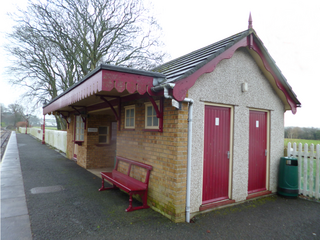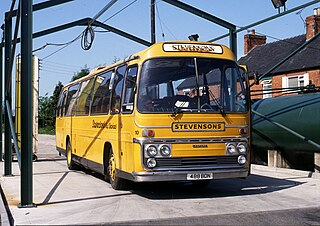
A level crossing is an intersection where a railway line crosses a road or path, or in rare situations an airport runway, at the same level, as opposed to the railway line crossing over or under using an overpass or tunnel. The term also applies when a light rail line with separate right-of-way or reserved track crosses a road in the same fashion. Other names include railway level crossing, railway crossing, grade crossing or railroad crossing, road through railroad, criss-cross, train crossing, and RXR (abbreviated).
The Glen Waverley railway line is a suburban electric railway in Melbourne, Australia, operated by Metro Trains Melbourne. It branches from the Lilydale, Belgrave and Alamein lines at Burnley station. It has 12 stations in PTV ticketing zones 1 and 2.

Caldon Canal is a branch of the Trent and Mersey Canal which opened in 1779. It runs 18 miles (29 km) from Etruria, Stoke-on-Trent, to Froghall, Staffordshire. The canal has 17 locks and the 76-yard (69 m) Froghall Tunnel.

The Uttoxeter Canalpronounced (listen) (help·info) was a thirteen-mile extension of the Caldon Canal running from Froghall as far as Uttoxeter in Staffordshire, England. It was authorised in 1797, but did not open until 1811. With the exception of the first lock and basin at Froghall, it closed in 1849, in order that the Churnet Valley line of the North Staffordshire Railway could be constructed along its length. The railway has since been dismantled and there are plans to reinstate the canal.
On 6 January 1968, a low-loader transporter carrying a 120-ton electrical transformer was struck by a British Rail express train on a recently installed automatic level crossing at Hixon, Staffordshire, England.

Lydney railway station is a railway station serving the town of Lydney in Gloucestershire, England. It is located on the Gloucester-Newport line. The station is located a mile south of Lydney, and was originally called Lydney Junction, which is now the name of the nearby station on the preserved Dean Forest Railway.

Uttoxeter railway stationpronounced (listen) (help·info) in Uttoxeter, Staffordshire, England, is served by trains on the Crewe-Derby Line, which is also a Community rail line known as the North Staffordshire line. The station is owned by Network Rail and managed by East Midlands Railway. The full range of tickets for travel are purchased from the guard on the train at no extra cost since there are no retail facilities at this station. It is the closest railway station to Alton Towers to which it is linked by a semi-regular bus service. A taxi rank also exists just next to the station.

Eccles Road railway station is on the Breckland line in the east of England, serving the villages of Eccles, Quidenham and Wilby in Norfolk. The line runs between Cambridge in the west and Norwich in the east.

The Great Whipsnade Railway, also known as The Jumbo Express, is an English, 2 ft 6 in narrow gauge heritage railway that operates within ZSL Whipsnade Zoo in Bedfordshire, England.

Shippea Hill railway station is on the Breckland Line in the east of England, serving the Burnt Fen area of Cambridgeshire and Suffolk. The line runs between Cambridge in the west and Norwich in the east.

Ballasalla railway station is located in the village of Ballasalla in the south of the Isle of Man, close to the airport, and is served on a seasonal basis by the Isle of Man Railway. It forms part of the sole remaining section of the once extensive network that operated across the island. Ballasalla was the usual crossing point for trains, making it popular with photographers, until the introduction of the 2015 timetable which saw all trains passing at Castletown and the effective closure of Ballasalla as a staffed station, save for special events.

Littlehaven railway station serves the areas of Littlehaven, Holbrook and Roffey in the northeast of the town of Horsham, West Sussex, England. It is on the Arun Valley Line, 36 miles 50 chains (58.9 km) down the line from London Bridge, measured via Redhill.

Hensall railway station serves the village of Hensall in North Yorkshire, England. It is located on the Pontefract Line and is 22 miles (35 km) east of Leeds. The line is used regularly by the freight companies GB Railfreight, Freightliner and DB Cargo UK that transport coal and limestone to Drax and remove the gypsum created by the flue-gas treatment equipment. The branch line to the power plant diverges just to the east of the station and was formerly supervised from the nearby signal box, but is now remotely controlled from Ferrybridge signalling centre.
Clayton Bridge railway station, Manchester, was a railway station that served the locality between 1846 and 1968.
One of the characteristics of the Isle of Man Railway are the numerous level crossings and farm crossings along the various routes; many smaller crossing places are marked only by gates the criss-cross farm land and provide access to individual private roads which connect the farms to the main roads. Being largely rural in nature the railway has many of these scattered along the existing South Line, and there were, as one might expect, many more on the closed sections of the railway. These can be summarised as follows, along with other points of interest along the line not covered in the Isle of Man Railway stations section:-

Redwood railway station on the suburban rail network of Wellington, New Zealand, is on the North Island Main Trunk Railway (NIMT). Opening in late 1963, it is double tracked with staggered side platforms; the up platform is on the north side of the Tawa Street level crossing, the down platform on the south. The station serves the suburb of Redwood.

Stevensons of Uttoxeter was a bus company that operated in Staffordshire from 1926.

There are around 6,000 level crossings in the United Kingdom, of which about 1,500 are public highway crossings. This number is gradually being reduced as the risk of accidents at level crossings is considered high. The director of the UK Railway Inspectorate commented in 2004 that "the use of level crossings contributes the greatest potential for catastrophic risk on the railways." The creation of new level crossings on the national network is banned, with bridges and tunnels being the more favoured options. The cost of making significant reductions, other than by simply closing the crossings, is substantial; some commentators argue that the money could be better spent. Some 5,000 crossings are user-worked crossings or footpaths with very low usage. The removal of crossings can improve train performance and lower accident rates, as some crossings have low rail speed limits enforced on them to protect road users. In fact, between 1845 and 1933, there was a 4 miles per hour (6.4 km/h) speed limit on level crossings of turnpike roads adjacent to stations for lines whose authorising Act of Parliament had been consolidated in the Railways Clauses Consolidation Act 1845 although this limit was at least sometimes disregarded.
Designs of level crossings, where railway lines cross roads or other paths, vary country-to-country.














